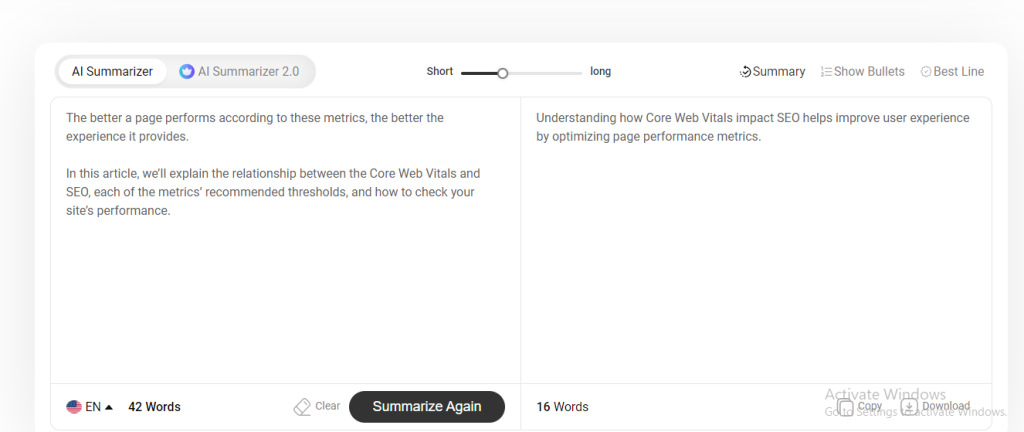|
Download ESL Books + Free PDFs
Save 25% on ESL Books for Teachers & Students Visit the ESL Expat Store and enter "SAVE25" at checkout! |

Writing a summary is necessary whether you’re crafting a blog post, a research paper, or a social media post’s description from an article.
A summary is a shorter version of a longer piece of writing that outlines the main idea to the audience. While it is recommended to limit a summary to one paragraph, its length can vary as per the length of the original text.

How to write a good, concise summary? What are the tips and tricks to improve your summary writing skills? Read this guide to learn this!
Know Your ‘Why’
First, ask yourself the exact purpose of summarizing the text.
Do you want to refresh your memory for a test? Is it a quick brief for a business meeting? Are you repurposing a blog post? Knowing the purpose influences tone, style, details to add, and approach to summarize text.
Read and Extract Key Points
Once you know the purpose to summarize, read the original content thoroughly. Don’t just skim; instead, actively engage with the text. Ask yourself:
- What is the main point the author is trying to convey?
- Are there sub-points that support the main idea?
Underline key points or write them down separately. Remember, you need only the facts, not the author’s personal views. Even when you write, DO NOT include your and the author’s personal views in the summary.
Write a Summary With Factual Information
This is where we actually start to write a summary following these tips and tricks:
Give Your Summary a Proper Structure
A summary should have these three parts:
- A topic sentence
- A body section to support the topic
- A conclusion statement
Begin with a sentence that mentions the original source’s title and author and establishes the main topic.
For example, you can start by writing it like this: “According to James Luther in ‘The Snow and a Man’”. Then, include your main topic, also called the thesis statement afterward to drive a natural-looking conversation.
Add enough supporting sentences to prove the thesis statement. Mentioning again, focus on facts, not personal views. End the summary with a conclusion statement to leave an effective, engaging, and lasting impression.
| TIP: Mix short and long sentences to keep your summary engaging. Use transition words like “however,” or “furthermore,” to connect ideas and create a clear flow. |
‘MUST’ Include the Key Information
In case the original text discusses a person, event, or concept that you think is necessary to understand the main idea, briefly mention them in your summary.
And if the text explores a cause-and-effect relationship, be sure to include how one event leads to another in your summary.
Keep the Summary Concise
The ultimate motto of writing a summary is to discuss a long chunk of text in one or two paragraphs. Therefore, you should follow these:
NO Redundancy—Avoid repeating unnecessary information.
Use Strong Verbs—Replace weak verbs with stronger verbs that convey action or meaning.
Go For Less Examples—Summaries shouldn’t include all the examples from the original text. Briefly mention one or two that effectively illustrate the main point.
Some of you may face hurdles in keeping the summary brief without skipping any details or compromising on quality. For them, a summary generator will act as a lifesaver.

The tool will quickly condense the input text by retaining only important points while keeping the original meaning and quality unchanged. So, as a learner, you should mimic the online generator approach and start practicing writing concisely to elevate your overall skills.
Proofread the Summarized Text
Once you have crafted the summary, go through it and see
- Does it make sense?
- Does it clearly convey the main points as the original text?
- Are there any grammatical or spelling errors?
In case the conveys a different message than the original text, rewrite it again. And if there are some errors, get rid of them to give it a smooth look.
Conclusion
First, understand the purpose of summarizing the text. Is it for a test, meeting, or repurposing content? Once you understand your ‘why’, read the original text thoroughly, focusing on key points and facts.
Structure your summary with a clear topic sentence, supporting details, and a conclusion. Mention the source and main topic when writing a summary. Avoid personal opinions.
Keep your writing concise. For this, avoid redundancy, use strong verbs, and limit the number of examples you use. Proofread to ensure clarity and correctness, and paraphrase if needed to avoid plagiarism.
More Blog Articles for Teaching and Learning English:
- Enhancing Classroom Participation for Students with Speech Disorders
- Hot Seat Game Words and Idioms for Learning English
- Mastering English Listening Skills: 21 Strategies for Language Students
- Fear-Setting Activity for English Language Learners
- What Are The EPIK, JET, FET, and NET Programs For Teaching English?
- The Life And Evolution Of An ESL Teacher
- Managing Culture Shock When Working Abroad
